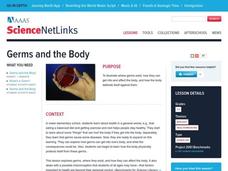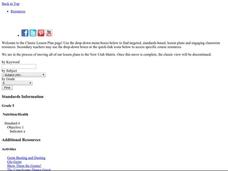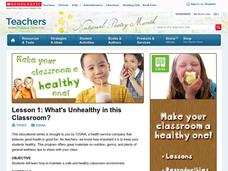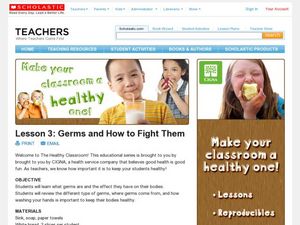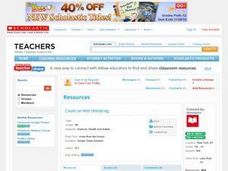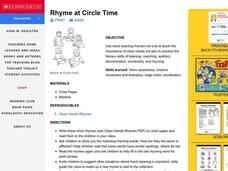Curated OER
Dirty Hands Can Make You Sick
A word bank of "dirty words" are used to fill in the blanks of 9 questions. For this keeping healthy worksheet, students use a word bank to complete sentences. A good resource for young students.
Curated OER
Germs: Learning Not to Share
Young scholars have cinnamon sprinkled onto their hands and walk around the room touching objects within their reach. Students observe all of the objects containing cinnamon fingerprints to visualize where and how germs are spread.
Curated OER
Disease Prevention and HIV/AIDS Education
Young scholars discuss communicable and non-communicable diseases, and how germs travel from person to person through the air, on objects, in body fluids, and on animals and insects. They take a short quiz.
Curated OER
Germs Experiment
Young scholars observe how germs grow on three germ covered potato slices and one control slice. They study the scientific method, how germs form and the importance of hand washing.
Curated OER
Germs and Preventing Illness: An Inner and Outer
First graders looks at germs through a microscope and identify two that can make us sick. They compare their mouth before and after they brush their teeth and practice proper hand washing techniques. They study the impact of Edward...
Curated OER
Immune System: The Master of Self-Defense
Students examine the role of the immune system in the human body. They conduct a hand-washing experiment, answer questions while viewing videos, discuss key vocabulary, draw and label illustrations, and observe demonstrations and record...
Curated OER
What Did I Touch Today?
Young scholars investigate germs and how they travel. They graph the places in the classroom that have been touch by students to determine which five places have had the most contact. They write stories from a germ's point of view.
Curated OER
Potato Experiment
Spur a discussion of germs using this lesson. Learners conduct an experiment with potatoes to determine how germs are transmitted. They then discuss ways to prevent the spread of germs. The emphasis is on hand washing.
Curated OER
Keep It Clean…Or Pass It Around
Learners identify the harmful and beneficial effects of bacteria. In this biology lesson, students test the effectiveness of antibacterial cleaners. They create a presentation based on researched information and experimental results.
Curated OER
Germs and the Body
Students explore biology by completing an illness worksheet. In this human germs instructional activity, students identify how germs are transferred from one body to another and the prevention methods that can be taken. Students complete...
Curated OER
Hand Washing: I Can Handle It!
Fifth graders examine virus transmission. For this health and nutrition lesson, 5th graders explore hand washing and food handling techniques that prevent food borne illnesses. Students name viruses and the diseases caused by them
Curated OER
Why Does My Body Smell?
Fourth graders investigate how germs spread among people. In this health instructional activity, 4th graders discover the causes of infection and proper hygiene methods.
Curated OER
Invasion of the Germs: We Fight Back!
Students fight off germs. In this technology skills lesson, students create claymation videos with accompanying podcasts that educate others about the H1N1 virus and methods to fight germs.
Curated OER
Germ Busters!
Students create healthy podcasts. In this personal health lesson, students apply their knowledge of viruses and bacteria to script and record a podcast to be shared with younger students as well as parents and administrators.
Curated OER
One Bad Apple Spoils the Bunch
Pupils complete a science experiment on apples to learn about bacteria and the spread of viruses. In this germ experiment lesson plan, students follow a 10 step procedure to complete a study on viruses in apples.
Curated OER
Germs and Handwashing Lesson
Students explore how proper handwashing can prevent the spreading of germs. In this handwashing instructional activity, students use glitter and cooking spray to demonstrate how germs spread. Students will wash their hands correctly and...
Curated OER
Health Education: Germs
Second graders examine germs. In this personal health lesson plan, 2nd graders summarize the methods for preventing the spread of germs through food, water, air, and touch.
Curated OER
Lesson 1: What's Unhealthy in this Classroom?
Students discover behaviors and practices that are unhealthy within their classroom environment. In this early childhood lesson plan, students identify behaviors and practices that lead to an unhealthy environment, and discuss how to...
Curated OER
Germs and How to Fight Them
Students learn how important it is to stay healthy. In this germ lesson plan, student learn what germs are and the effect they have on healthy bodies and explore how important it is to keep their bodies healthy through a classroom...
Curated OER
Count on Wet Ones??
Students listen to fingerplay songs, clean hands with Wet Ones wipe or squirt of hand sanitizer, sing Five Little Monkeys Jumping on the Bed, discuss what would happen if monkeys were germs on their hands, and use their hands and...
Curated OER
Germs and Microbes
Students observe how to clean their hands with antibacterial wipes or instant hand sanitizers. They discuss the steps to germ fighting and use reproducibles, fingerplays, and songs to reinforce that cleaning hands and fighting germs are...
Curated OER
What Did I Touch Today?
Second graders describe and adopt behaviors for health and safety. They explore what germs are and how they can make you sick. Through graphing activities, 2nd graders examine the way germs travel and what they can do to prevent the...
Curated OER
Tag the Germs
Students review what happens when they wipe germs off their hands with a wet wipe. Next, they play a game of tag in which some students are germs and others are wipes. They move around while music plays, stop when it stops, and the wipes...
Curated OER
Rhyme at Circle Time
Students study the importance of clean hands and practice the literacy skills of listening, matching, auditory discrimination, vocabulary, and rhyming. They illustrate their rhyme chart with drawings or photos taken doing the different...











